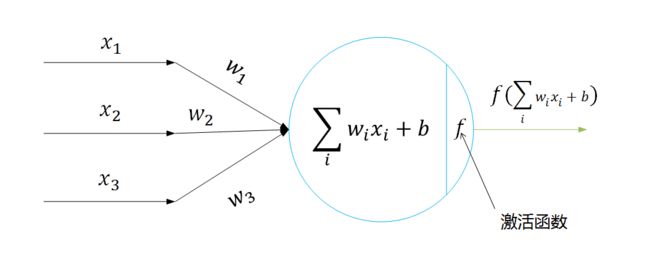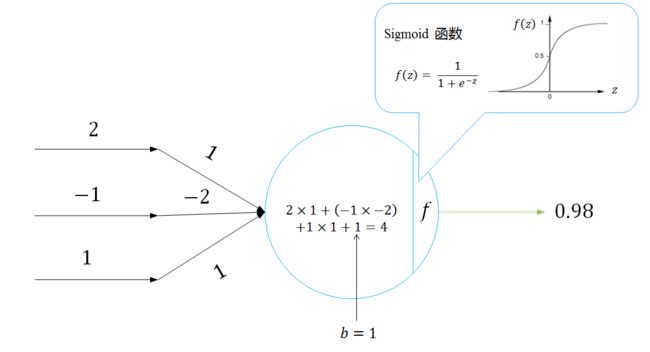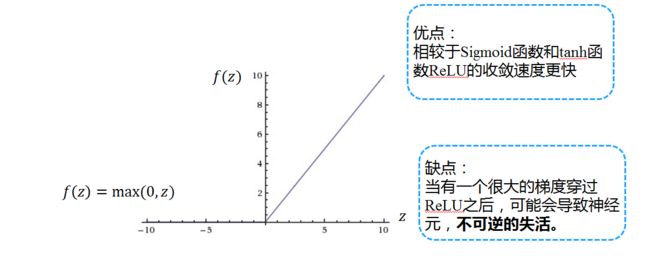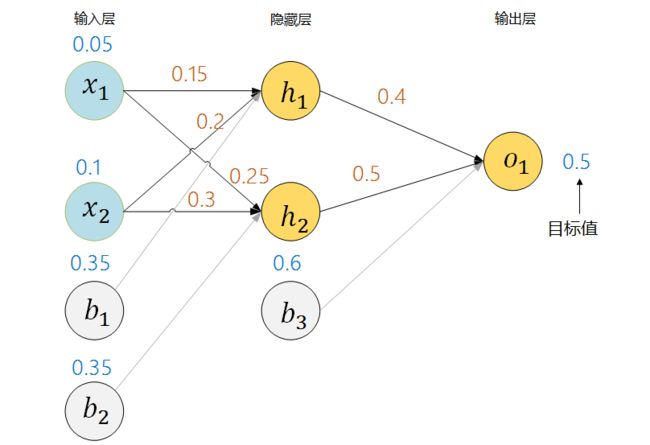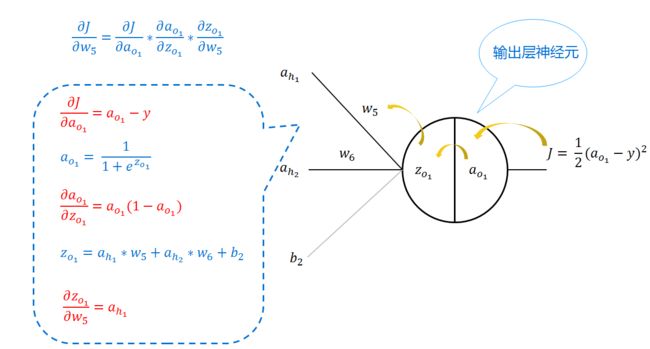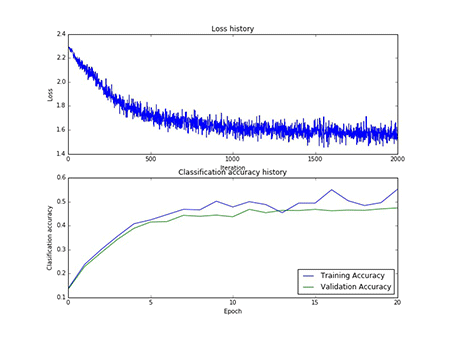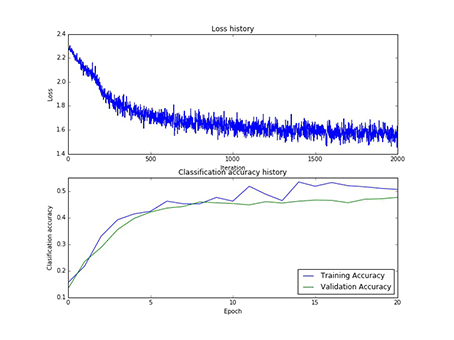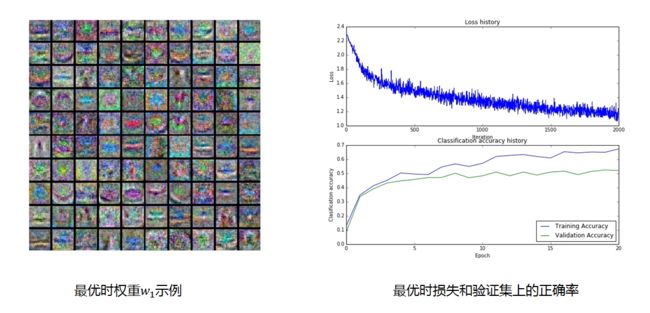人工神经网络
一、神经网络的模型:
图1 两层全连接神经网络模型
这个是一个带有两个全连接层的神经网络,神经网络,一般不把输入层算在层数之中。
1、神经元:
图2 神经元的数学模型
从单个神经元来看,每个神经元可以看做是一个感知机,可以用来做决策,从图中可以看出,根据输入的线性组合,经过函数f来预测,比如Sigmoid函数,当输出值大于0.5的时候可以判定为正类,当输出值小于0.5的时候,可以判定为负类。这像什么?逻辑回归!举个神经元的例子:
图3 神经元示例
2、激活函数
激活函数有很多种类,比如,线性函数、Sigmoid函数、tanh函数、ReLU函数等,本文只列举三个类型的激活函数:
图4 Sigmoid函数和tanh函数
Sigmoid函数和tanh函数,有一个共同的问题就是,当数据很大的时候,就是图中两个所指的方向,在反向传播的过程中,会导致梯度消失。神经元的激活值在0或者1附近的时候,梯度几乎为零,那么在反向传播的时候梯度就会被“杀死”。其实很好理解,在两个所指方向上,函数越来越趋于水平,因此在求导的时候,所得梯度为0或者很小---近似于0,这样在反向传播的时候,梯度就为零了(或者近似于0),因此梯度就消失了,权重就无法更新,因此这两个函数在神经网络中不在常用。但是相比较而言tanh比Sigmoid函数要更受欢迎,因为tanh的数据输出是中心化的。
图5 ReLU函数
ReLU的优缺点图中已经的说明,但是对于缺点,我的理解是:当有一个特别大的梯度经过的时候,权重会被更新为一个特别小的负数(比如负无穷),那么当再次经过该神经元的时候,该神经元的输入值为负数,那么ReLU输出值就是0了,但是依旧会有梯度来更新对应权重,但是更新的值不足以让该神经元的输入值为正(就好比一个负无穷加上一个整数N,它依旧是一个很小的数),那么这样就会导致该神经元的不可逆转的失活。
那么到此可以对神经网络有一个理解:可以认为神经网络定义了一个由一系列的函数组成的函数族,网络的权重就是函数中的参数,神经经网络可以近似任何函数。(这个是被证明了的)。
二、前向传播和反向传播:
前向传播很简单,如下一个例子:
图6 神经网络示例
蓝色数字代表对应权重和偏值的数值,我们的目标是让这神经网络输出值为0.5或者非常接近0.5.
计算隐藏层神经元h1的输入,0.15 * 0.05 + 0.2 * 0.1 + 0.35 = 0.38,h1的输出:f(0.38) = 0.59,其中f为Sigmoid函数,同理可以计算出神经元h2的输入和输出。于是有下图:
图7 前向传播示例
由于输出值为0.63,不是我们想要的0.5,最起码不太接近0.5,那么我们就要更新权重和偏值,训练神经网络的目的就是训练权重和偏值,他们使得网络输出我们想要的结果。那么如何来更新权重呢?采用反向传播的方法,反向传播其实很简单,说白一点就是一系列的链式求导,本文不准备讲理论推到,具体的理论推到请看:
http://blog.csdn.net/hearthougan/article/details/55812728
我也不建议只看理论推到,看懂了,不如找一个小例子实际推到一番来的透彻,本文只简单讲一下如何的反向传播,比如我们现在得到了损失,也有了损失函数,我们要更新w5、w6、和b3,要更新他们,就要分别求出它们的梯度,现以求w5的梯度来说明,如下图:
图8 反向传播示例
w5如果懂了,其他的也就是知道了。假设学习率为0.5,那么最后更新权重为:
三、在CIFAR10和MNIST数据集上的实验结果
为了试验神经网络的效果我在,CIFAR10和MNIST上各测试了一下,MNIST的准确率为97.2%,而CIFAR10只有52%,但是相比较SVM和Softmax,神经网络的正确率还是提高了很多,之所以在CIFAR10上的正确率不高,个人认为它的图片背景更加复杂,图片为三通道的,而MNIST的图片背景就比较简单而且是单通道的。
本实验总共采用了75次寻参,其中隐藏层神经元的个数有[50, 75, 100]三类,每一类寻参(学习率和正则项)过程中,第一层权重W1的样子,和对应的损失以及在训练集合验证集上的正确率,现以gif的形式呈现:
1、现展示CIFAR10:
图9 50个神经元对应的W1和50个神经元寻参时对应的损失和正确率
图10 75个神经元对应的W1和75个神经元寻参时对应的损失和正确率
图11 100个神经元对应的W1和100个神经元寻参时对应的损失和正确率
在CIFAR10数据集上整个寻参之后,得到的最优W1和对应的损失以及正确率如下:
图12 最优参数显示
在寻到最优参数之后,在测试集上的正确率为52%
MNIST数据集显示:
(Sorry)MNIST数据集的gif超过2M,无法上传,只贴一张最优参数的静态图图吧:
在测试集上的正确率97.2%
全连接代码:
# -*- coding: utf-8 -*-
"""
Created on Fri May 19 23:23:42 2017
@author: Abner
"""
import numpy as np
import matplotlib.pyplot as plt
class TwoLayerNet(object):
"""
一个两层的全连接神经网络,输入层的神经元的个数为D,隐藏层的神经元的个数为:H,
输出层神经元的个数为C,利用Softmax损失函数和L2正则项来训练神经网络,第一个
全连接层的激活函数为ReLU
网络的结构为:
输入层 - 全连接层(第一个隐藏层) - ReLU - 全连接层(输出层) - Softmax
第二全连接层是输出层,输出的结果就是每个类别的得分。
"""
def __init__(self, input_size, hidden_size, output_size, std = 1e-4):
"""
初始化模型:
权重被初始化很小的随机值,偏值被初始化为0,权重和偏值存放在self.params中,
params是一个字典结构:
W1:第一个全连接层的权重,大小为:(D, H)
b1:第一层的偏值,大小为:(H,)
W2:第二个全连接层的权重,大下为:(H, C)
b2:第二层的偏值,大小为:(C,)
input_size:输入层的维数,D
hidden_size:隐藏层神经元的个数,H
output_size:输出层类别数,C
"""
self.params = {}
self.params['W1'] = std * np.random.rand(input_size, hidden_size)
self.params['b1'] = np.zeros(hidden_size)
self.params['W2'] = std * np.random.rand(hidden_size, output_size)
self.params['b2'] = np.zeros(output_size)
def loss(self, X, y = None, reg = 0.0):
"""
计算两层全连接神经网络的损失和梯度。
输入:
X:数据的输入大小为(N, D),每个X[i]是一个样本
y: 训练样本标签,y[i]是X[i]对应的标签,参数y是可选择的,如果没有对y传参,
那么该损失函数只返回得分;如果传参,那么loss就返回损失和梯度。
reg:正则系数
返回:
如果y为空,返回一个大小为(N, C)的scores矩阵,其中scores[i, c]是样本X[i]是类别
c时的得分。
如果y不为空,那么就返回一个元组:
-loss:每批训练样本的损失,数据损失和正则损失
-grads:一个字典,存放的是权重(或者是偏值)和其对应的梯度
"""
W1, b1 = self.params['W1'], self.params['b1']
W2, b2 = self.params['W2'], self.params['b2']
N, D = X.shape
#计算前向传播
scores = None
f = lambda x : np.maximum(0, x)
h1 = f(np.dot(X, W1) + b1)
h2 = np.dot(h1, W2) + b2
scores = h2
if y is None:
return scores
loss = None
shift_scores = scores - np.max(scores, axis = 1).reshape(-1, 1)
softmax_output = np.exp(shift_scores)/np.sum(np.exp(shift_scores), axis = 1).reshape(-1, 1)
loss = -np.sum(np.log(softmax_output[range(N), list(y)]))
loss /= N
loss += reg * 0.5 * (np.sum(W1 * W1) + np.sum(W2 * W2))
#反向传播,计算梯度
grads = {}
"""
计算反向传播,对权重和偏值进行求导,然后存放在一个字典中 ,比如,grads['W1']
应该存放W1的梯度,grads的梯度应该和W1的大小是相同的,grads['b1']与b1的大小
是相同的。
"""
#得分对应损失函数的梯度
descores = softmax_output.copy()#N*C
descores[range(N), list(y)] -= 1#N*C
grads['W2'] = 1.0/N * h1.T.dot(descores) + reg * W2#H*C
grads['b2'] = 1.0/N * np.sum(descores, axis = 0)#C*1
dh1 = descores.dot(W2.T)#N*H
dh1_ReLU = (X.dot(W1) + b1 > 0) * dh1#N*H
grads['W1'] = 1.0/N * X.T.dot(dh1_ReLU) + reg * W1#D*H
grads['b1'] = 1.0/N * np.sum(dh1_ReLU, axis = 0)#H*!
return loss, grads
def train(self, X, y, X_val, y_val, learning_rate = 1e-3,
learning_rate_decay = 0.95, reg = 1e-5, num_iters = 100,
batch_size = 200, verbose = False):
"""
训练神经网络,利用随机梯度
输入:
X:(N,D)
y:(N,)
X_val:给定的验证数据集,(N_val, D)
y_val:给定验证集的标签,(N_val,)
learning_rate:最优化时候的步长
learning_rate_decay:用于每个epoch学习率减少的标量值
reg:正则强度
num_iters:最优化时迭代的次数
batch_size:每批样本的个数
verbose:布尔值,如果为真,就打印最优化的过程
"""
num_train = X.shape[0]
iterations_per_epoch = max(num_train/batch_size, 1)
#使用随机梯度(SGD)来最优化self.model中的参数
loss_history = []
train_acc_history = []
val_acc_history = []
for it in range(num_iters):
X_batch = None
y_batch = None
"""
TODO:
创建一个训练数据集和对应标签的随机minibatch,并把他们分别储存在X_batch和y_batch
"""
idx = np.random.choice(num_train, batch_size, replace = True)
X_batch = X[idx]
y_batch = y[idx]
#利用当前的minibatch来计算损失和梯度
loss, grads = self.loss(X_batch, y = y_batch, reg = reg)
loss_history.append(loss)
"""
TODO:
利用self.params中的梯度来更新网络中的参数
"""
self.params['W1'] = self.params['W1'] - learning_rate*grads['W1']
self.params['W2'] = self.params['W2'] - learning_rate*grads['W2']
self.params['b1'] = self.params['b1'] - learning_rate*grads['b1']
self.params['b2'] = self.params['b2'] - learning_rate*grads['b2']
if verbose and it % 100 == 0:
print 'iteratrion %d / %d: loss %f' % (it, num_iters, loss)
#每个epoch检查训练、验证集上的准确率,以及缩减学习率
if it % iterations_per_epoch == 0:
#检验正确率
train_acc = (self.predict(X_batch) == y_batch).mean()
val_acc = (self.predict(X_val) == y_val).mean()
train_acc_history.append(train_acc)
val_acc_history.append(val_acc)
#缩减学习率
learning_rate *= learning_rate_decay
return {
'loss_history':loss_history,
'train_acc_history':train_acc_history,
'val_acc_history':val_acc_history,
}
def predict(self, X):
"""
利用已经训练好权重的两层全连接神经网络训来预测数据的标签,对于每一数据我们预测
C个类别的得分,然后把得分最高的标签定位数据的标签。
输入:
- X输入数据,N*D
返回:
- y_pred:给定数据集对应的预测标签
"""
y_pred = None
f = lambda x: np.maximum(0, x)
h1 = f(np.dot(X, self.params['W1']) + self.params['b1'])
h2 = np.dot(h1, self.params['W2']) + self.params['b2']
scores = h2
y_pred = np.argmax(scores, axis = 1)
return y_pred
# -*- coding: utf-8 -*-
"""
Created on Sun May 7 19:32:30 2017
@author: admin
"""
import numpy as np
import pickle
import os
def Load_CIFAR_Batch(filename):
with open(filename, 'rb') as f:
datadict = pickle.load(f)
X = datadict['data']
Y = datadict['labels']
X = X.reshape(10000, 3, 32, 32).transpose(0, 2, 3, 1).astype('float')#1000*32*32*3
Y = np.array(Y)
return X, Y
def Load_CIFAR10(Root):
xs = []
ys = []
for b in range(1, 6):
f = os.path.join(Root, 'data_batch_%d'%(b, ))
X, Y = Load_CIFAR_Batch(f)
xs.append(X)
ys.append(Y)
Xtr = np.concatenate(xs)
Ytr = np.concatenate(ys)
del X, Y
Xte, Yte = Load_CIFAR_Batch(os.path.join(Root, 'test_batch'))
return Xtr, Ytr, Xte, Yte
# -*- coding: utf-8 -*-
"""
Created on Sun May 21 16:58:49 2017
@author: Abner
"""
'''
使用python解析二进制文件
'''
import numpy as np
import cPickle as pickle
import struct
def Load_MNIST(Data_dir,label_dir):
"""
读取数据
"""
binfile = open(Data_dir, 'rb') # 读取二进制文件
buffers = binfile.read()
head = struct.unpack_from('>IIII', buffers, 0) # 取前4个整数,返回一个元组
offset = struct.calcsize('>IIII') # 定位到data开始的位置
imgNum = head[1]
width = head[2]
height = head[3]
bits = imgNum * width * height # data一共有60000*28*28个像素值
bitsString = '>' + str(bits) + 'B' # fmt格式:'>47040000B'
imgs = struct.unpack_from(bitsString, buffers, offset) # 取data数据,返回一个元组
binfile.close()
imgs = np.reshape(imgs, [imgNum, width * height]) # reshape为[60000,784]型数组
""""
读取Label
"""
binfile = open(label_dir, 'rb') # 读二进制文件
buffers = binfile.read()
head = struct.unpack_from('>II', buffers, 0) # 取label文件前2个整形数
labelNum = head[1]
offset = struct.calcsize('>II') # 定位到label数据开始的位置
numString = '>' + str(labelNum) + "B" # fmt格式:'>60000B'
labels = struct.unpack_from(numString, buffers, offset) # 取label数据
binfile.close()
labels = np.reshape(labels, [labelNum]) # 转型为列表(一维数组)
return imgs, labels
def Load_MNIST_Data():
train_path_lable_dir = 'MNIST\\train-labels.idx1-ubyte'
train_path_Data_dir = 'MNIST\\train-images.idx3-ubyte'
test_path_Data_dir = 'MNIST\\t10k-images.idx3-ubyte'
test_path_lable_dir = 'MNIST\\t10k-labels.idx1-ubyte'
Xtr, ytr = Load_MNIST(train_path_Data_dir ,train_path_lable_dir)
Xte, yte = Load_MNIST(test_path_Data_dir, test_path_lable_dir)
return Xtr, ytr, Xte, yte
"""
if __name__ == "__main__":
Xtr, ytr, Xte, yte = Load_MNIST_Data()
print("Xtr: ", Xtr.shape)
print("ytr: ", ytr.shape)
print('----------我是分割线-----------')
print("Xte: ", Xte.shape)
print("yte: ", yte.shape)
"""
权重可视化:
# -*- coding: utf-8 -*-
"""
Created on Sun May 21 19:08:24 2017
@author: Abner
"""
from math import sqrt, ceil
import numpy as np
def visualize_grid(Xs, ubound=255.0, padding=1):
"""
Reshape a 4D tensor of image data to a grid for easy visualization.
Inputs:
- Xs: Data of shape (N, H, W, C)
- ubound: Output grid will have values scaled to the range [0, ubound]
- padding: The number of blank pixels between elements of the grid
"""
(N, H, W, C) = Xs.shape
grid_size = int(ceil(sqrt(N)))
grid_height = H * grid_size + padding * (grid_size - 1)
grid_width = W * grid_size + padding * (grid_size - 1)
grid = np.zeros((grid_height, grid_width, C))
next_idx = 0
y0, y1 = 0, H
for y in xrange(grid_size):
x0, x1 = 0, W
for x in xrange(grid_size):
if next_idx < N:
img = Xs[next_idx]
low, high = np.min(img), np.max(img)
grid[y0:y1, x0:x1] = ubound * (img - low) / (high - low)
# grid[y0:y1, x0:x1] = Xs[next_idx]
next_idx += 1
x0 += W + padding
x1 += W + padding
y0 += H + padding
y1 += H + padding
return grid
def visualize_grid1(Xs, ubound=255.0, padding=1):
"""
Reshape a 4D tensor of image data to a grid for easy visualization.
Inputs:
- Xs: Data of shape (N, H, W)
- ubound: Output grid will have values scaled to the range [0, ubound]
- padding: The number of blank pixels between elements of the grid
"""
(N, H, W) = Xs.shape
grid_size = int(ceil(sqrt(N)))
grid_height = H * grid_size + padding * (grid_size - 1)
grid_width = W * grid_size + padding * (grid_size - 1)
grid = np.zeros((grid_height, grid_width))
next_idx = 0
y0, y1 = 0, H
for y in xrange(grid_size):
x0, x1 = 0, W
for x in xrange(grid_size):
if next_idx < N:
img = Xs[next_idx]
low, high = np.min(img), np.max(img)
grid[y0:y1, x0:x1] = ubound * (img - low) / (high - low)
# grid[y0:y1, x0:x1] = Xs[next_idx]
next_idx += 1
x0 += W + padding
x1 += W + padding
y0 += H + padding
y1 += H + padding
return grid
def vis_grid(Xs):
""" visualize a grid of images """
(N, H, W, C) = Xs.shape
A = int(ceil(sqrt(N)))
G = np.ones((A*H+A, A*W+A, C), Xs.dtype)
G *= np.min(Xs)
n = 0
for y in range(A):
for x in range(A):
if n < N:
G[y*H+y:(y+1)*H+y, x*W+x:(x+1)*W+x, :] = Xs[n,:,:,:]
n += 1
# normalize to [0,1]
maxg = G.max()
ming = G.min()
G = (G - ming)/(maxg-ming)
return G
def vis_nn(rows):
""" visualize array of arrays of images """
N = len(rows)
D = len(rows[0])
H,W,C = rows[0][0].shape
Xs = rows[0][0]
G = np.ones((N*H+N, D*W+D, C), Xs.dtype)
for y in range(N):
for x in range(D):
G[y*H+y:(y+1)*H+y, x*W+x:(x+1)*W+x, :] = rows[y][x]
# normalize to [0,1]
maxg = G.max()
ming = G.min()
G = (G - ming)/(maxg-ming)
return G
# -*- coding: utf-8 -*-
"""
Created on Sat May 20 10:55:11 2017
@author: Abner
"""
import numpy as np
import matplotlib.pyplot as plt
import matplotlib
matplotlib.use('Agg')
from vis_uitls import visualize_grid
from vis_uitls import visualize_grid1
from LoadData import Load_CIFAR10
from Load_MNIST import Load_MNIST_Data
from Fullc_NN import TwoLayerNet
#matplotlib inline
plt.rcParams['figure.figsize'] = (10.0, 8.0) # set default size of plots
plt.rcParams['image.interpolation'] = 'nearest'
plt.rcParams['image.cmap'] = 'gray'
# for auto-reloading external modules
# see http://stackoverflow.com/questions/1907993/autoreload-of-modules-in-ipython
#%load_ext autoreload
#%autoreload 2
#读取MNIST数据集
##############################################################################
def get_MNIST_data(num_training=59000, num_validation=1000, num_test=1000):
"""
Load the CIFAR-10 dataset from disk and perform preprocessing to prepare
it for the two-layer neural net classifier. These are the same steps as
we used for the SVM, but condensed to a single function.
"""
# Load the raw CIFAR-10 data
X_train, y_train, X_test, y_test = Load_MNIST_Data()
X_train = X_train.reshape(60000, 28, 28)
X_test = X_test.reshape(10000, 28, 28)
print "Before reshape Data:"
print "X_train: ", X_train.shape
print "y_train: ", y_train.shape
print "X_test: ", X_test.shape
print "y_test: ", y_test.shape
# Subsample the data
mask = range(num_training, num_training + num_validation)
X_val = X_train[mask]
y_val = y_train[mask]
mask = range(num_training)
X_train = X_train[mask]
y_train = y_train[mask]
mask = range(num_test)
X_test = X_test[mask]
y_test = y_test[mask]
# Normalize the data: subtract the mean image
mean_image = np.mean(X_train, axis=0)
X_train = X_train - mean_image
X_val = X_val - mean_image
X_test = X_test - mean_image
# Reshape data to rows
X_train = X_train.reshape(num_training, -1)
X_val = X_val.reshape(num_validation, -1)
X_test = X_test.reshape(num_test, -1)
return X_train, y_train, X_val, y_val, X_test, y_test
##########################################################################
'''
def get_CIFAR10_data(num_training=49000, num_validation=1000, num_test=1000):
"""
Load the CIFAR-10 dataset from disk and perform preprocessing to prepare
it for the two-layer neural net classifier. These are the same steps as
we used for the SVM, but condensed to a single function.
"""
# Load the raw CIFAR-10 data
cifar10_dir = 'cifar-10-batches-py'
X_train, y_train, X_test, y_test = Load_CIFAR10(cifar10_dir)
print "Before reshape Data:"
print "X_train: ", X_train.shape
print "y_train: ", y_train.shape
print "X_test: ", X_test.shape
print "y_test: ", y_test.shape
# Subsample the data
mask = range(num_training, num_training + num_validation)
X_val = X_train[mask]
y_val = y_train[mask]
mask = range(num_training)
X_train = X_train[mask]
y_train = y_train[mask]
mask = range(num_test)
X_test = X_test[mask]
y_test = y_test[mask]
# Normalize the data: subtract the mean image
mean_image = np.mean(X_train, axis=0)
X_train -= mean_image
X_val -= mean_image
X_test -= mean_image
# Reshape data to rows
X_train = X_train.reshape(num_training, -1)
X_val = X_val.reshape(num_validation, -1)
X_test = X_test.reshape(num_test, -1)
return X_train, y_train, X_val, y_val, X_test, y_test
'''
# Invoke the above function to get our data.
#X_train, y_train, X_val, y_val, X_test, y_test = get_CIFAR10_data()
#MNIST
X_train, y_train, X_val, y_val, X_test, y_test = get_MNIST_data()
print 'Train data shape: ', X_train.shape
print 'Train labels shape: ', y_train.shape
print 'Validation data shape: ', X_val.shape
print 'Validation labels shape: ', y_val.shape
print 'Test data shape: ', X_test.shape
print 'Test labels shape: ', y_test.shape
'''
##############################################################################
"""
不经过寻参,隐藏层设置神经元个数为50个
"""
#输入层神经元的个数是数据的维数,隐藏层神经元的个数为50个,输出层神经元的个数为10个
#input_size = 32 * 32 * 3
input_size = 28*28
hidden_size = 50
num_classes = 10
net = TwoLayerNet(input_size, hidden_size, num_classes)
# Train the network
stats = net.train(X_train, y_train, X_val, y_val,
num_iters=1000, batch_size=200,
learning_rate=1e-4, learning_rate_decay=0.95,
reg=0.5, verbose=True)
# Predict on the validation set
val_acc = (net.predict(X_val) == y_val).mean()
print 'Validation accuracy: ', val_acc
plt.subplot(2, 1, 1)
plt.plot(stats['loss_history'])
plt.title('Loss history')
plt.xlabel('Iteration')
plt.ylabel('Loss')
plt.subplot(2, 1, 2)
train_acc, = plt.plot(stats['train_acc_history'], label='train')
val_acc, = plt.plot(stats['val_acc_history'], label='val')
plt.legend([train_acc, val_acc], ['Training Accuracy', 'Validation Accuracy'], loc='lower right')
plt.title('Classification accuracy history')
plt.xlabel('Epoch')
plt.ylabel('Clasification accuracy')
#plt.show()
plt.savefig('E:\\MNIST\\loss.jpg')
plt.close()
#def show_net_weights(net):
# W1 = net.params['W1']
# W1 = W1.reshape(32, 32, 3, -1).transpose(3, 0, 1, 2)
# plt.imshow(visualize_grid(W1, padding=3).astype('uint8'))
# plt.gca().axis('off')
## plt.show()
# plt.savefig('E:\\MNIST\\weight.jpg')
def show_net_weights(net):
W1 = net.params['W1']
W1 = W1.reshape(28, 28, -1).transpose(2, 0, 1)
plt.imshow(visualize_grid1(W1, padding=1).astype('uint8'))
plt.gca().axis('off')
# plt.show()
plt.savefig('E:\\MNIST\\weight.jpg')
show_net_weights(net)
##############################################################################
'''
# best_net = None # store the best model into this
#################################################################################
# TODO: Tune hyperparameters using the validation set. Store your best trained #
# model in best_net. #
# #
# To help debug your network, it may help to use visualizations similar to the #
# ones we used above; these visualizations will have significant qualitative #
# differences from the ones we saw above for the poorly tuned network. #
# #
# Tweaking hyperparameters by hand can be fun, but you might find it useful to #
# write code to sweep through possible combinations of hyperparameters #
# automatically like we did on the previous exercises. #
#################################################################################
stats = {}
results = {}
best_val = -1
best_stats = None
#input_size = 32 * 32 * 3
input_size = 28*28
num_classes = 10
# hidden_sizes = (100 * np.random.rand(5)).round().astype(int)
# learning_rates = (5e-3 - 5e-5) * np.random.rand(5) + 5e-5
# regularization_strengths = np.random.rand(5)
# hidden_sizes = [50, 75, 100]
# learning_rates = [5e-4]
# regularization_strengths = [0.65, 0.75, 0.85]
# hidden_sizes = np.round(10 ** np.random.uniform(1.7,2.3,3)).astype(int)
#hidden_sizes = [100]
#CIFAR10
#def show_net_weights(net, k):
# W1 = net.params['W1']
# W1 = W1.reshape(32, 32, 3, -1).transpose(3, 0, 1, 2)
# plt.imshow(visualize_grid(W1, padding=3).astype('uint8'))
# plt.gca().axis('off')
# plt.savefig('E:\\NN\\%d times_W.jpg' % k)
# plt.show()
def show_net_weights(net, k):
W1 = net.params['W1']
W1 = W1.reshape(28, 28, -1).transpose(2, 0, 1)
plt.imshow(visualize_grid1(W1, padding=1).astype('uint8'))
plt.gca().axis('off')
plt.savefig('E:\\MNIST\\%d times_W1.jpg' % k)
hidden_sizes = [50, 75, 100]
learning_rates = 10 ** np.random.uniform(-3.5,-2.5,5)
regularization_strengths = 10 ** np.random.uniform(-5,1,5)
k = 0
for hidden_size in hidden_sizes:
for learning_rate in learning_rates:
for regularization_strength in regularization_strengths:
# Print hyperparameters
print 'Size = %d, Learning rate = %e, Reg. Strength = %e' % (
hidden_size, learning_rate, regularization_strength)
# Initialize net
net = TwoLayerNet(input_size, hidden_size, num_classes)
# Training
stats[hidden_size, learning_rate, regularization_strength] = \
net.train(X_train, y_train, X_val, y_val,
num_iters=2000, batch_size=500,
learning_rate=learning_rate, learning_rate_decay=0.95,
reg=regularization_strength, verbose=True)
# Testing
y_train_pred = net.predict(X_train)
y_val_pred = net.predict(X_val)
# Evaluation
train_num_correct = np.sum(y_train_pred == y_train)
training_accuracy = float(train_num_correct) / X_train.shape[0]
val_num_correct = np.sum(y_val_pred == y_val)
validation_accuracy = float(val_num_correct) / X_val.shape[0]
results[hidden_size, learning_rate, regularization_strength] = training_accuracy, validation_accuracy
if validation_accuracy > best_val:
best_val = validation_accuracy
best_net = net
best_stats = stats[hidden_size, learning_rate, regularization_strength]
current_stats = stats[hidden_size, learning_rate, regularization_strength]
# Plot the loss function and train / validation accuracies
plt.subplot(2, 1, 1)
plt.plot(current_stats['loss_history'])
plt.title('Loss history')
plt.xlabel('Iteration')
plt.ylabel('Loss')
plt.subplot(2, 1, 2)
train_acc, = plt.plot(current_stats['train_acc_history'], label='train')
val_acc, = plt.plot(current_stats['val_acc_history'], label='val')
plt.legend([train_acc, val_acc], ['Training Accuracy', 'Validation Accuracy'], loc = 'lower right')
plt.title('Classification accuracy history')
plt.xlabel('Epoch')#寻参的时候,每次训练时,验证集和训练集的正确率
plt.ylabel('Clasification accuracy')
# plt.show()
k += 1
plt.savefig('E:\\MNIST\\%d times_Loss.jpg' % (k))
# visualize the weights of the current network
plt.close()
print "第%d次寻参的权重" % k
show_net_weights(net, k)
pass
# Print out results.
for hid_size, lr, reg in sorted(results):
train_accuracy, val_accuracy = results[(hid_size, lr, reg)]
print 'size %d lr %e reg %e train accuracy: %f val accuracy: %f' % (
hid_size, lr, reg, train_accuracy, val_accuracy)
print 'best validation accuracy achieved during cross-validation: %f' % best_val
plt.close()
# Plot the loss function and train / validation accuracies
plt.subplot(2, 1, 1)
plt.plot(best_stats['loss_history'])
plt.title('Loss history')
plt.xlabel('Iteration')
plt.ylabel('Loss')
plt.subplot(2, 1, 2)
train_acc, = plt.plot(best_stats['train_acc_history'], label='train')
val_acc, = plt.plot(best_stats['val_acc_history'], label='val')
plt.legend([train_acc, val_acc], ['Training Accuracy', 'Validation Accuracy'], loc = 'lower right')
plt.title('Classification accuracy history')
plt.xlabel('Epoch')
plt.ylabel('Clasification accuracy')
#plt.show()
plt.savefig('E:\\MNIST\\Best_Loss.jpg')
plt.close()
# visualize the weights of the current network
print "最优时候的权重:"
show_net_weights(best_net, 0)
pass
#################################################################################
# END OF YOUR CODE #
#################################################################################
#test_acc = (best_net.predict(X_test) == y_test).mean()
#print 'Test accuracy: ', test_acc
test_acc = (best_net.predict(X_test) == y_test).mean()
print 'Test accuracy: ', test_acc
